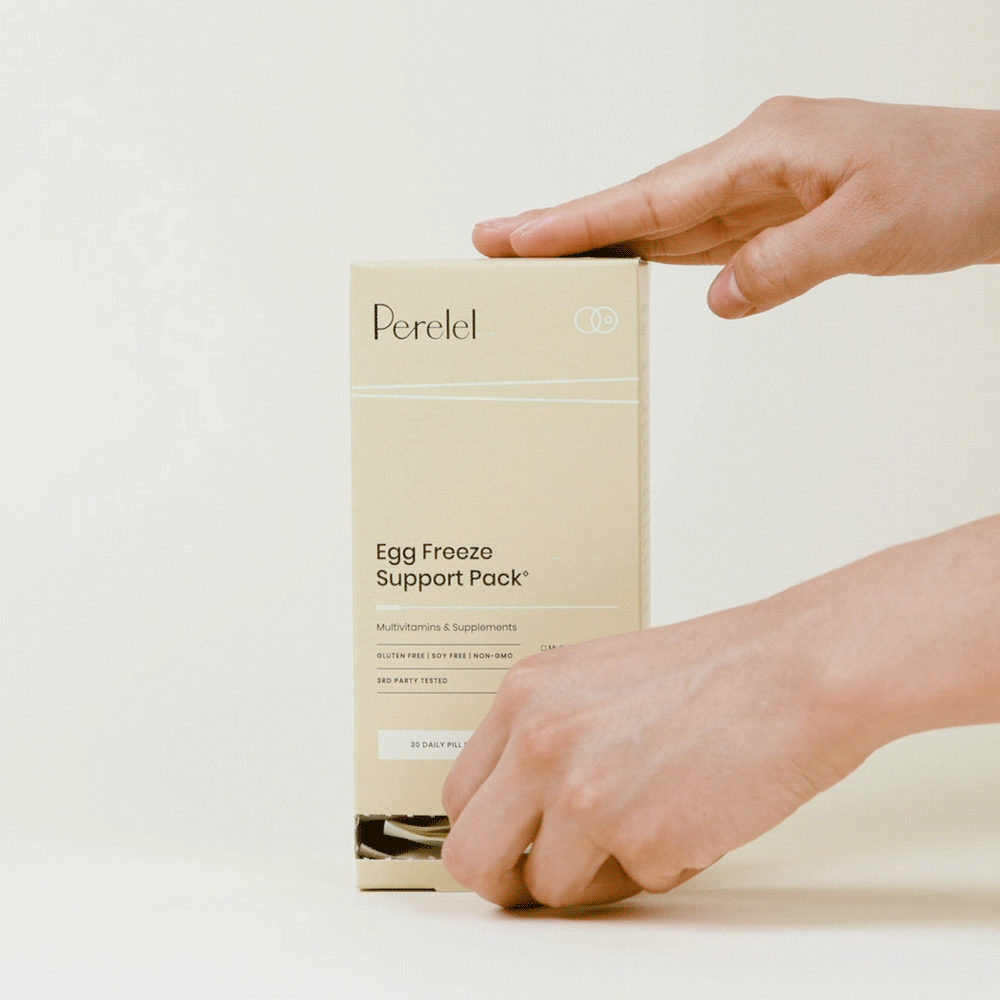For those pursuing their dreams of expanding their families, it's undeniable that scientific advancements have provided more pathways than ever before—and statistics show that Americans are taking advantage. According to Pew Research Center, 42 percent of adults in the United States reported that they or someone they know has used fertility treatments in an attempt to get pregnant.1
The reasons women seek out fertility treatment are varied. For example, they may struggle with infertility, which the Centers for Disease Control defines as “not being able to get pregnant (conceive) after one year (or longer) of unprotected sex.”1 Others may need fertility treatment if for other reasons—for example, same-sex couples working with a sperm donor or women that became infertile following a medical diagnosis. That's not to mention cultural shifts: Many woman are choosing to become parents later in life, and while the "fertility cliff" is something of a myth, age does play a role in our chances of getting pregnant.
But despite growing demand, the cost of fertility treatment can be an intense financial strain. According to the U.S. Department of Health and Human Services, In Vitro Fertilization (more commonly known as IVF) is the most common form of assisted reproductive technology (ART), representing more than 99 percent of total procedures.2 And with all the expenses associated with IVF—including doctor’s visits, blood tests, imaging, medication, and procedural costs—the total cost can easily surpass $10,000 (or more) for a single round.
Let’s take a deeper look at the cost of fertility treatment in the United States, including total expenses and statistics that impact treatment costs:
The Numbers
$12,400: the average cost of an IVF cycle in the US
According to data outlined in a 2022 review and assessment from the National Library of Medicine (a branch of the National Institutes of Health), the average cost of an IVF cycle in the United States is $12,400.3 However, the review also cites that IVF costs can significantly exceed that average—particularly since many women need more than one cycle of IVF to successfully give birth.
$60,000: the cost of live births in certain (expensive) parts of the country
Where you’re receiving IVF and giving birth can also play a large role in costs. According to the NLM review, the cost per live birth can exceed $60,000 in more expensive parts of the United States. And while most insurance plans will cover a portion of the bill, the average American will pay $3,500 in out-of-pocket pregnancy expenses—without the additional layer of fertility treatment.
29.5%: The percentage of women that give birth after one cycle of IVF
As mentioned, many women need more than one cycle of IVF. One study featured in the Journal of the American Medical Association (JAMA) of over 156,000 women found that the live-birth rate for the first cycle of IVF was 29.5 percent—which means over 70 percent of the women studied needed more than one cycle of IVF in order to successfully give birth.4
Shop the Article:
271%: the increased cost of IVF in the US vs. other countries
While fertility treatments are expensive across the globe, costs in the United States can be extreme. According to the NLM review, research has shown that an IVF cycle in the US costs an astounding 271 percent more than the mean cost of an IVF cycle in 25 other countries.
67%: patients that report spending more than $10,000 on fertility treatment
According to a whitepaper from the ASRM, 67 percent of patients receiving infertility care report spending $10,000 or more on their treatment. The whitepaper also cited a survey, which found that, on average, women between the ages of 25 and 34 accrued $30,000 in debt from undergoing fertility treatment.5
21 and 1: The number of states and districts with fertility insurance coverage laws
According to The National Infertility Association, there are currently 21 states and one district that have passed fertility insurance coverage laws, which require some private insurance companies to provide a degree of coverage for infertility. They include:
- California
- Utah
- Colorado
- Montana
- Texas
- Arkansas
- Louisiana
- Illinois
- Kentucky
- Ohio
- West Virginia
- Washington, D.C.
- Maryland
- Delaware
- New Jersey
- New York
- Connecticut
- Rhode Island
- Massachusetts
- New Hampshire
- Maine
- Hawaii
Of those states and districts with fertility insurance coverage laws, 15 laws include IVF coverage and 17 cover fertility preservation for medically induced infertility.6 Insurance mandates are imperfect in achieving equal access to and use of infertility treatments because they are able to reach only a portion of the population in the mandated state. Most mandates apply only to persons who have private insurance, and only to those policies that must comply with the state insurance law. This means that infertility coverage may not be available to people who are uninsured, who obtain health coverage through Medicaid or other government programs, or who obtain health insurance from employers that are either self-insured, too small to be subject to the mandate (e.g., mandates in Illinois, Maryland, and New Jersey apply only to employers over a certain size), or based outside of the mandated state.7
50%: The percentage of disposable income a patient may spend on one cycle of IVF in the United States
While some states mandate IVF coverage, many do not. As such, many fertility patients in the United States will pay for their medical treatment out of pocket, either because they don’t have insurance coverage or because their coverage doesn’t offer fertility benefits. According to data cited by the ASRM, a single cycle of IVF may represent 50 percent of the average patient’s annual disposable income—while patients that require additional cycles will spend even more.
1.5%: the number of births attributed to assisted reproductive technology (ART) in the United States
According to the American Society of Reproductive Medicine (ASRM), assisted reproductive technology (also known as ART) accounts for approximately 1.5 percent of all births in the United States—about half the number of births in Europe (which is cited at about 3 percent) and even less for countries that offer publicly funded IVF, including Sweden (3.5 percent), Belgium (4 percent), and Denmark (5.9 percent).8
Beyond the high price tag, there are a host of racial, ethnic, and geographic disparities that further impact both access to fertility treatments and treatment outcomes. The distribution of OB/GYNs and IVF centers varies widely from state to state, with the highest concentrations of IVF centers and male reproductive specialists found in states with mandated IVF insurance and high median income.7 Fertility treatments are time-consuming, requiring patients to take significant time off from work for office visits to medical facilities that may be geographically distant.
There are also more specific gaps experienced by Black, LGBTQ, and Latina women, with women of color, for example, having reported that some physicians brush off their fertility concerns, assume they can get pregnant easily, emphasize birth control over procreation, and may even dissuade them from having children.7 As Jessica Grose writing for The New York Times summarizes, "Until better policy is in place, fertility treatment will remain a fantasy for millions, and the technologies on the horizon will be accessible only for the privileged few."
In the United States, healthcare disparities are pervasive and infertility prevention and treatment are not exceptions. Better resources and more equitable access to women's healthcare starts with female-centered research. You can join our Pledge to #FUNDWOMENSHEALTH to fund women's health research and directly provide more access to essential reproductive care.
References:
- Goddard, Isabel, and Carolina Aragão. Fertility Treatment Use in the US. Pew Research Center, 14 September 2023.
- Centers of Disease Control. Infertility FAQs.
- U.S. Department of Health and Human Services. March 2024. Fact Sheet: In Vitro Fertilization (IVF) Use Across the United States.
- National Library of Medicine. 2022. Impact of In Vitro Fertilization State Mandates for Third Party Insurance Coverage in the United States.
- American Society of Reproductive Medicine. 2021. Disparities in Access to Effective Treatment for Infertility.
- The National Infertility Association. 2023. Insurance Coverage by State.
- Disparities in Access to Effective Treatment for Infertility in the United States (2021). ASRM.
- The Journal of the American Medical Association. December 2015. Live-Birth Rate Associated With Repeat In Vitro Fertilization Treatment Cycles.





























